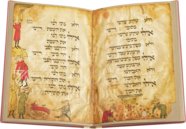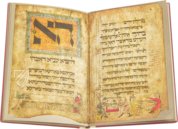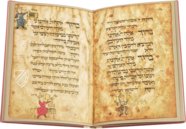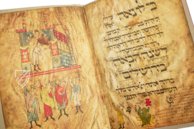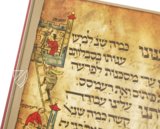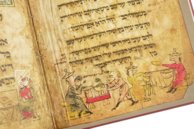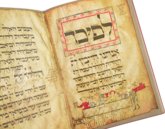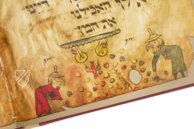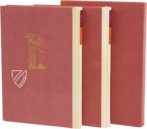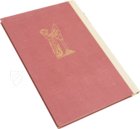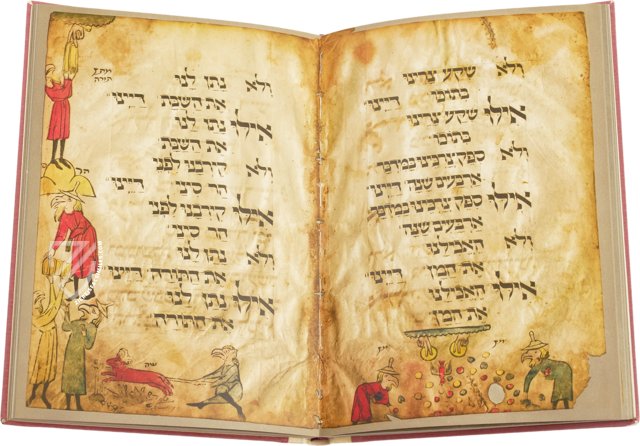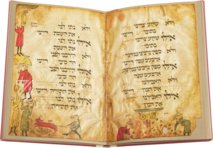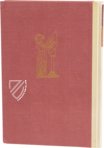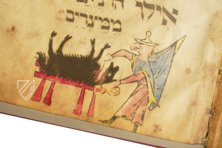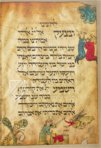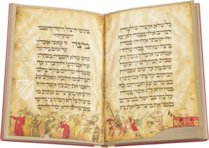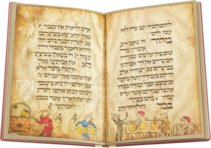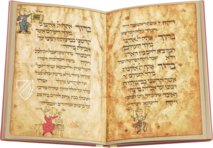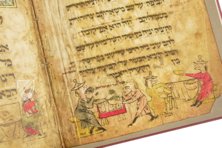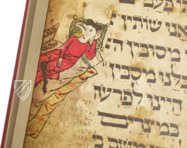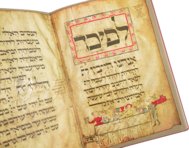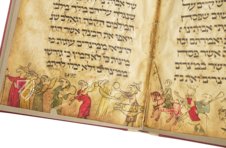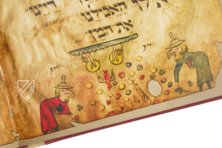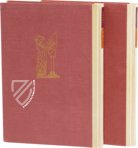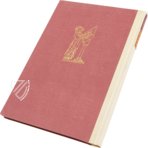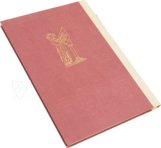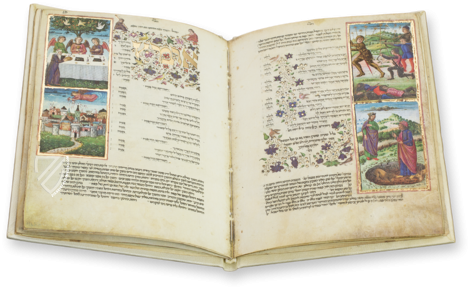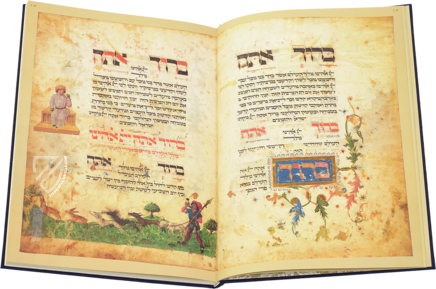Birds' Head Haggadah
(1,000€ - 3,000€)
The name of this early Passover Haggadah derives from its depiction of human figures with pronounced birds’ heads. The enigmatic practice of drawing bird and animal heads in place of human faces is found in other Ashkenazi manuscripts of the 13th and 14th centuries and has been interpreted in various ways. This is the first illustrated Haggadah known to be produced as an entity separate from the prayer book. It contains depictions with ritual and textual themes: the preparation of matzah and the various blessings over wine and food recited during the Seder; biblical scenes like the gathering of the manna or the giving of the Torah; and messianic images such as the rebuilt Jerusalem. 2 full-page miniatures and 33 decorative borders adorn the text concerning the Seder, the ritualized feast of Passover.
Birds' Head Haggadah
As the central event of the Passover festival, the ritualized meal of Seder is one of the oldest and most important traditions in Judaism and one that would not be complete without a Haggadah to guide the participants through the meal and the story surrounding it. This manuscript created ca. 1300 is the oldest surviving Ashkenazi Haggadah and originated in the Upper Rhine region of southern Germany, possibly near Würzburg. Furthermore, it is the first to be bound separately and not part of a larger Hebrew prayer book. The text is executed in block calligraphy and is adorned by colorful illustrations showing people participating in the Seder as well as some depictions of historical events. A curious feature of this manuscript is that all the Jewish figures are depicted with the faces and beaks of birds, hence its name the Birds’ Head Haggadah. Non-Jews and the faces of angels, the sun, and moon are all blank but the reason for this unusual artistic program is unclear and debated. Nonetheless, the fascinating and whimsical illustrations of the manuscript make it a true jewel of medieval illumination.
A Famous Scribe
The hand responsible for the neatly written text is identified by the Hebrew name מנחם or Menahem, who is also credited with creating the Leipzig Machzor among other fine Hebrew manuscripts. Each page has twelve rows of text written in block calligraphy with dark brown ink and tempera on parchment. Smaller, more densely written script can be found in the margins with additional details for conducting the Seder and abiding by the laws that pertain to Passover, likely added at a later date, and similar “captions” have been added to certain illustrations.
A Feast for Birds
Two full-page miniatures are found in the text, one at the beginning and the other at the end of the text. The opening miniature shows a husband and wife seated at their Seder table while the closing miniature is a vision of a rebuilt Jerusalem in the messianic era. 33 of the text pages found between these images are adorned by marginal illustrations that closely follow the text and show both the feast itself and historical events associated with it. Images of the feast include roasting of the Paschal lamb, baking and breaking matzo bread, as well as grinding and eating bitter herbs. Other scene show the Jewish people fleeing Egypt with their unleavened bread, the pursuit of the Pharaoh to the banks of the Red Sea, Moses receiving the Ten Commandments and presenting the Pentateuch to his people, and the Jews receiving manna from heaven while wandering the desert. Jewish figures are dressed in contemporary German clothing with the pointed “Jewish hat” that was mandated by the Fourth Lateran Council in 1215 shown being worn by leaders and teachers such as Moses. Finally, the bird’s heads on their bodies are not uniform but are individualized.
Debated Birds’ Heads
Various theories attempt to explain the peculiar artistic choices made in this work. Some argue it was a way to avoid the Second Commandment’s prohibition of graven images and other Jewish manuscripts use animal head substitutes as well. Others claim they are the heads of eagles – a possible reference to the heraldic symbol of the Holy Roman Emperor, under whose protection German Jews lived, or that they are actually the heads of griffins and not birds, pointing to the common use of lion-eagle-human hybrids in Jewish iconography. They could even be a tongue-in-cheek allusion to the animal-head gods worshipped by the ancient Egyptians. Debates over the imagery, and whether it was Jewish or Christian artists who created them, continue to swirl around the manuscript.
A Contested Ownership
It is not known who commissioned the work or who owned it for most of the last 700 years, but in the 20th century the manuscript was owned by the family of Johanna Benedikt. The manuscript was presented as a wedding present to her new husband, the German Jewish lawyer and parliamentarian Ludwig Marum (1882-1934) who lived in Karslruhe. The manuscript disappeared after he was arrested in 1933 and sent to a concentration camp where he was murdered in the following year. It resurfaced in Jerusalem in 1946 in the possession of a German Jewish refugee named Herbert Kahn, who sold it to the predecessor institution of the Israel Museum for $600. The Marum family maintains that Kahn had no right to sell the manuscript and have demanded compensation for the manuscript but also maintain that it should be kept on exhibition in the museum for the public good. Indeed, many works of art stolen in the course of World War II face similar legal disputes over ownership.
Codicology
- Alternative Titles
- Vogelkopf-Haggadah
Marum Haggadah - Size / Format
- 94 pages / 27.0 × 18.2 cm
- Origin
- Germany
- Date
- Ca. 1300
- Epochs
- Language
- Script
- Ashkenazi square script
- Illustrations
- 2 colorful full-page miniatures and 33 pages of fascinating narrative border illustrations
- Content
- The full Hebrew text of the Haggadah
- Artist / School
- Menahem (scribe)
- Previous Owners
- Johanna Benedikt
Ludwig Marum
Herbert Kahn
Bezalel National Museum
Birds' Head Haggadah
Quail and Manna from Heaven
In Exodus 16, the Israelites are still wandering through the desert and are starving. Such is their suffering that they think fondly of their captivity in Egypt when they sat around pots of meat and now question their decision. God sends them relief in the form of quail, which arrive at twilight to provide meat, and manna, which appears in the morning like dew and consists of fine flakes that they gather and bake into bread. This bas-de-page shows two bird-headed Israelites gather red, blue, and gold flakes as they fall from the sky where God’s hands can be seen extending down from heaven with a single quail included for good measure.

Birds' Head Haggadah
The Binding of Isaac
Got puts Abraham to the ultimate test of faith in Genesis 22 – the sacrifice of his only son. Before departing to the mountain specified by God, Abraham (blue) and Isaac (red) are shown kneeling together with their hands folded in prayer in the upper right corner. In the bas-de-page, the angel of the Lord appears at the last moment and literally stays Abraham’s sword with their divine hand:
Then he reached out his hand and took the knife to slay his son. But the angel of the Lord called out to him from heaven, “Abraham! Abraham!” “Here I am,” he replied. “Do not lay a hand on the boy,” he said. “Do not do anything to him. Now I know that you fear God, because you have not withheld from me your son, your only son.” Abraham looked up and there in a thicket he saw a ram caught by its horns. He went over and took the ram and sacrificed it as a burnt offering instead of his son. (Genesis 22: 10-13)

#1 Birds' Head Haggadah
Languages: English, Hebrew
(1,000€ - 3,000€)
- Treatises / Secular Books
- Apocalypses / Beatus
- Astronomy / Astrology
- Bestiaries
- Bibles / Gospels
- Chronicles / History / Law
- Geography / Maps
- Saints' Lives
- Islam / Oriental
- Judaism / Hebrew
- Single Leaf Collections
- Leonardo da Vinci
- Literature / Poetry
- Liturgical Manuscripts
- Medicine / Botany / Alchemy
- Music
- Mythology / Prophecies
- Psalters
- Other Religious Books
- Games / Hunting
- Private Devotion Books
- Other Genres
- Afghanistan
- Armenia
- Austria
- Belgium
- Colombia
- Croatia
- Cyprus
- Czech Republic
- Denmark
- Egypt
- Ethiopia
- France
- Germany
- Greece
- Hungary
- India
- Iran
- Iraq
- Israel
- Italy
- Japan
- Lebanon
- Luxembourg
- Mexico
- Morocco
- Netherlands
- Palestine
- Peru
- Poland
- Portugal
- Russia
- Serbia
- Spain
- Sri Lanka
- Sweden
- Switzerland
- Syria
- Turkey
- Ukraine
- United Kingdom
- United States
- Uzbekistan
- Aboca Museum
- Ajuntament de Valencia
- Akademie Verlag
- Akademische Druck- u. Verlagsanstalt (ADEVA)
- Aldo Ausilio Editore - Bottega d’Erasmo
- Alecto Historical Editions
- Alkuin Verlag
- Almqvist & Wiksell
- Amilcare Pizzi
- Andreas & Andreas Verlagsbuchhandlung
- Archa 90
- Archiv Verlag
- Archivi Edizioni
- Arnold Verlag
- ARS
- Ars Magna
- ArtCodex
- AyN Ediciones
- Azimuth Editions
- Badenia Verlag
- Bärenreiter-Verlag
- Belser Verlag
- Belser Verlag / WK Wertkontor
- Benziger Verlag
- Bernardinum Wydawnictwo
- BiblioGemma
- Biblioteca Apostolica Vaticana (Vaticanstadt, Vaticanstadt)
- Bibliotheca Palatina Faksimile Verlag
- Bibliotheca Rara
- Boydell & Brewer
- Bramante Edizioni
- Bredius Genootschap
- Brepols Publishers
- British Library
- C. Weckesser
- Caixa Catalunya
- Canesi
- CAPSA, Ars Scriptoria
- Caratzas Brothers, Publishers
- Carus Verlag
- Casamassima Libri
- Chavane Verlag
- Christian Brandstätter Verlag
- Circulo Cientifico
- Club Bibliófilo Versol
- Club du Livre
- CM Editores
- Collegium Graphicum
- Collezione Apocrifa Da Vinci
- Comissão Nacional para as Comemorações dos Descobrimentos Portugueses
- Coron Verlag
- Corvina
- CTHS
- D. S. Brewer
- Damon
- De Agostini/UTET
- De Nederlandsche Boekhandel
- De Schutter
- Deuschle & Stemmle
- Deutscher Verlag für Kunstwissenschaft
- DIAMM
- Droz
- E. Schreiber Graphische Kunstanstalten
- Ediciones Boreal
- Ediciones Grial
- Ediclube
- Edições Inapa
- Edilan
- Editalia
- Edition Deuschle
- Edition Georg Popp
- Edition Leipzig
- Edition Libri Illustri
- Editiones Reales Sitios S. L.
- Éditions de l'Oiseau Lyre
- Editions Medicina Rara
- Editorial Casariego
- Editorial Mintzoa
- Editrice Antenore
- Editrice Velar
- Edizioni Edison
- Egeria, S.L.
- Eikon Editores
- Electa
- Emery Walker Limited
- Enciclopèdia Catalana
- Eos-Verlag
- Ephesus Publishing
- Ernst Battenberg
- Eugrammia Press
- Extraordinary Editions
- Fackelverlag
- Facsimila Art & Edition
- Facsimile Editions Ltd.
- Facsimilia Art & Edition Ebert KG
- Faksimile Verlag
- Feuermann Verlag
- Folger Shakespeare Library
- Franco Cosimo Panini Editore
- Friedrich Wittig Verlag
- Fundación Hullera Vasco-Leonesa
- G. Braziller
- Gabriele Mazzotta Editore
- Gebr. Mann Verlag
- Gesellschaft für graphische Industrie
- Getty Research Institute
- Giovanni Domenico de Rossi
- Giunti Editore
- Graffiti
- Grafica European Center of Fine Arts
- Guido Pressler
- Guillermo Blazquez
- Gustav Kiepenheuer
- H. N. Abrams
- Harrassowitz
- Helikon
- Hendrickson Publishers
- Henning Oppermann
- Herder Verlag
- Hes & De Graaf Publishers
- Hoepli
- Holbein-Verlag
- Hortus Deliciarum
- Houghton Library
- Hugo Schmidt Verlag
- Idion Verlag
- Il Bulino, edizioni d'arte
- ILte
- Imago
- Insel Verlag
- Instituto Nacional de Antropología e Historia
- Istituto dell'Enciclopedia Italiana - Treccani
- Istituto Ellenico di Studi Bizantini e Postbizantini
- Istituto Geografico De Agostini
- Istituto Poligrafico e Zecca dello Stato
- Italarte Art Establishments
- J. Thorbecke
- Jan Thorbecke Verlag
- Johnson Reprint Corporation
- Josef Stocker
- Josef Stocker-Schmid
- Jugoslavija
- Karl W. Hiersemann
- Kasper Straube
- Kaydeda Ediciones
- Kindler Verlag / Coron Verlag
- Kodansha International Ltd.
- Konrad Kölbl Verlag
- Kurt Wolff Verlag
- La Liberia dello Stato
- La Linea Editrice
- La Meta Editore
- Lambert Schneider
- Landeskreditbank Baden-Württemberg
- Leo S. Olschki
- Les Incunables
- Library of Congress
- Libreria Musicale Italiana
- Lichtdruck
- Lito Immagine Editore
- Lumen Artis
- Lund Humphries
- M. Moleiro Editor
- Maison des Sciences de l'homme et de la société de Poitiers
- Manuscriptum
- Martinus Nijhoff
- Maruzen-Yushodo Co. Ltd.
- MASA
- McGraw-Hill
- Militos
- Millennium Liber
- Müller & Schindler
- Nahar and Steimatzky
- National Library of Wales
- Neri Pozza
- Nova Charta
- Oceanum Verlag
- Odeon
- Orbis Mediaevalis
- Orbis Pictus
- Österreichische Staatsdruckerei
- Oxford University Press
- Pageant Books
- Parzellers Buchverlag
- Patrimonio Ediciones
- Pattloch Verlag
- PIAF
- Pieper Verlag
- Plon-Nourrit et cie
- Prestel Verlag
- Princeton University Press
- Prisma Verlag
- Priuli & Verlucca, editori
- Pro Sport Verlag
- Propyläen Verlag
- Pytheas Books
- Quaternio Verlag Luzern
- Reales Sitios
- Recht-Verlag
- Reichert Verlag
- Reichsdruckerei
- Riehn & Reusch
- Roberto Vattori Editore
- Rosenkilde and Bagger
- Roxburghe Club
- Salerno Editrice
- Sarajevo Svjetlost
- Schöck ArtPrint Kft.
- Scolar Press
- Scrinium
- Scripta Maneant
- Scriptorium
- Siloé, arte y bibliofilia
- SISMEL - Edizioni del Galluzzo
- Sociedad Mexicana de Antropología
- Société des Bibliophiles & Iconophiles de Belgique
- Soncin Publishing
- Sorli Ediciones
- Stainer and Bell
- Studer
- Styria Verlag
- Sumptibus Pragopress
- Szegedi Tudomànyegyetem
- Taberna Libraria
- Tarshish Books
- Taschen
- Tempus Libri
- Testimonio Compañía Editorial
- Thames and Hudson
- The Clear Vue Publishing Partnership Limited
- The Facsimile Codex
- The Folio Society
- The Marquess of Normanby
- The Richard III and Yorkist History Trust
- Tip.Le.Co
- TouchArt
- TREC Publishing House
- TRI Publishing Co.
- Trident Editore
- Typis Regiae Officinae Polygraphicae
- Union Verlag Berlin
- Universidad de Granada
- University of California Press
- University of Chicago Press
- Urs Graf
- Vallecchi
- Van Wijnen
- VCH, Acta Humaniora
- VDI Verlag
- VEB Deutscher Verlag für Musik
- Verlag Anton Pustet / Andreas Verlag
- Verlag Bibliophile Drucke Josef Stocker
- Verlag der Münchner Drucke
- Verlag für Regionalgeschichte
- Verlag Styria
- Vicent Garcia Editores
- W. Turnowsky
- Waanders Printers
- Wiener Mechitharisten-Congregation (Wien, Österreich)
- Wissenschaftliche Buchgesellschaft
- Wydawnictwo Dolnoslaskie
- Xuntanza Editorial
- Zakład Narodowy
- Zollikofer AG




